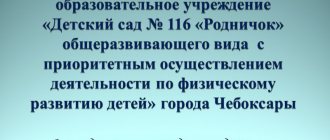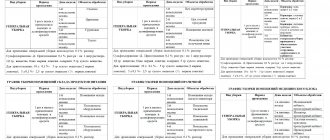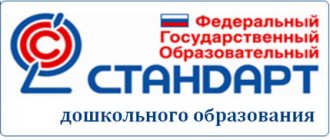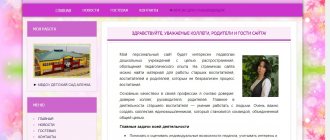The essence and types of educational programs for preschool educational institutions
The overwhelming number of preschool institutions are engaged in the general development of children, but even now, at the present stage, more and more institutions are appearing that pursue the following goals:
- early development of skills and abilities of preschool children (children's centers, kindergarten groups at lyceums and gymnasiums, etc.);
- combining in the process of raising healthy children with children who have problems in physical development;
- forming groups that function in conditions of learning two languages, and so on.
Are you an expert in this subject area? We invite you to become the author of the Directory Working Conditions
These changes in the work of preschool organizations occur in connection with the growing demands of parents who see the need to raise the level of development of children, to reveal certain abilities in children, as well as to prepare them for school. In addition, their cause is a change in the educational process itself in schools.
All existing preschool educational programs are divided into two large groups:
- comprehensive (general) programs that consist of the main areas in the development of children: speech, physical, cognitive, personal, social, aesthetic, artistic. They develop the child’s communicative, mental, creative, motor abilities, and also form specific types of activities - gaming, object-based, theatrical, musical, visual, etc.;
- partial (local) programs, consisting, as a rule, of one or several areas of child development.
Note 1
Integrity in the educational process can be achieved not only through the use of one comprehensive program, but also through the use of certain local programs.
Finished works on a similar topic
Coursework Modern educational programs for preschool educational institutions 470 ₽ Abstract Modern educational programs for preschool educational institutions 250 ₽ Test work Modern educational programs for preschool educational institutions 190 ₽
Receive completed work or specialist advice on your educational project Find out the cost
Structure of the educational program of preschool education
As was shown in the previous material “What is the federal state educational standard for preschool education (FSES DO)”, the federal state educational standard for preschool education (FSES DO), approved by Order of the Ministry of Education and Science of Russia dated October 17, 2013 No. 1155 “On approval of the federal state educational standard for preschool education” ", includes requirements for:
- the structure of the educational program of preschool education and its volume;
- conditions for the implementation of the educational program of preschool education and
- results of mastering the educational program of preschool education.
In this material, we will consider the features of the first of the specified requirements of the Federal State Educational Standard for Preschool Education - the requirements for the structure of the educational program of preschool education and its volume.
Requirements of the Federal State Educational Standard for Preschool Education for the structure of the educational program of preschool education
The educational program for preschool education determines:
- content and
- organization of educational activities at the level of preschool education.
Educational Preschool Education Program provides:
- personality development of preschool children in various types of communication and activities, taking into account their age, individual psychological and physiological characteristics and
- should be aimed at solving the problems defined by the federal state educational standard for preschool education (FSES DO).
Structural divisions (groups) in one educational organization of preschool education:
- can implement various educational programs of preschool education.
Educational Preschool Education Program is formed as a program:
- psychological and pedagogical support for positive socialization and individualization,
- personality development of preschool children and
- defines a set of basic characteristics of preschool education - volume, content and planned results in the form of targets for preschool education).
Educational Preschool Education Program is aimed at:
- creating conditions for the child’s development that open up opportunities for his positive socialization, his personal development,
- developing initiative and creativity through collaboration with adults and peers and age-appropriate activities;
- to create a developing educational environment, which is a system of conditions for the socialization and individualization of children.
The educational program for preschool education is developed and approved by:
- educational organization of preschool education independently
- in accordance with the Federal State Educational Standard for Preschool Education and taking into account the Model Preschool Education Programs.
When developing an educational program for preschool education, the educational organization of preschool education determines:
- duration of stay of children in the educational organization of preschool education,
- the operating mode of the educational organization of preschool education in accordance with the volume of educational tasks being solved,
- maximum group occupancy in an educational organization of preschool education.
An educational organization of preschool education can develop and implement in groups of an educational organization of preschool education various educational programs of preschool education with different lengths of stay of children during the day, including:
- groups of short-term stays for children,
- full-day and extended-day groups,
- round-the-clock stay groups,
- groups of children of different ages from two months to eight years,
- including different age groups.
The educational program of preschool education can be implemented during the entire period of children’s stay in the educational organization of preschool education.
When children stay in a group around the clock, the implementation of the educational program of preschool education is carried out for no more than 14 hours, taking into account the daily routine and age categories of the children.
Contents of the educational program of preschool education:
- should ensure the development of the personality, motivation and abilities of children in various types of activities and cover the following structural units, representing certain areas of development and education of children (educational areas):
social and communicative development;
- cognitive development;
- speech development;
- artistic and aesthetic development;
- physical development.
The social and communicative development of children in the Preschool Education Program is aimed at mastering the norms and values accepted in society, including:
- moral and moral values;
- development of communication and interaction of the child with adults and peers;
- the formation of independence, purposefulness and self-regulation of one’s own actions;
- development of social and emotional intelligence, emotional responsiveness, empathy, formation of readiness for joint activities with peers, formation of a respectful attitude and a sense of belonging to one’s family and to the community of children and adults in an educational organization of preschool education;
- the formation of positive attitudes towards various types of work and creativity;
- formation of the foundations of safe behavior in everyday life, society, and nature.
The cognitive development of the educational program of preschool education involves:
- development of children's interests, curiosity and cognitive motivation;
- formation of cognitive actions, formation of consciousness;
- development of imagination and creative activity;
- the formation of primary ideas about oneself, other people, objects of the surrounding world, about the properties and relationships of objects of the surrounding world (shape, color, size, material, sound, rhythm, tempo, quantity, number, part and whole, space and time, movement and rest , causes and consequences, etc.), about the small homeland and Fatherland, ideas about the socio-cultural values of our people, about domestic traditions and holidays, about planet Earth as the common home of people, about the peculiarities of its nature, the diversity of countries and peoples of the world.
Speech development of the educational program of preschool education includes:
- mastery of speech as a means of communication and culture;
- enrichment of the active vocabulary;
- development of coherent, grammatically correct dialogical and monologue speech; development of speech creativity;
- development of sound and intonation culture of speech, phonemic hearing;
- acquaintance with book culture, children's literature, listening comprehension of texts of various genres of children's literature;
- formation of sound analytical-synthetic activity as a prerequisite for learning to read and write.
The artistic and aesthetic development of the educational program of preschool education involves:
- development of prerequisites for value-semantic perception and understanding of works of art (verbal, musical, visual), the natural world;
- the formation of an aesthetic attitude towards the surrounding world;
- formation of elementary ideas about types of art;
- perception of music, fiction, folklore;
- stimulating empathy for characters in works of art;
- implementation of independent creative activities of children (visual, constructive-model, musical, etc.).
Physical development of the educational program of preschool education includes the acquisition of experience in the following types of children's activities:
- motor, including those associated with performing exercises aimed at developing physical qualities such as coordination and flexibility;
- promoting the correct formation of the musculoskeletal system of the body, the development of balance, coordination of movement, gross and fine motor skills of both hands, as well as the correct, non-damaging performance of basic movements (walking, running, soft jumps, turns in both directions), the formation of initial ideas about some sports, mastering outdoor games with rules;
- formation of focus and self-regulation in the motor sphere;
- the formation of healthy lifestyle values, mastery of its elementary norms and rules (in nutrition, physical activity, hardening, in the formation of useful habits, etc.).
The specific content of the specified educational areas of the educational program of preschool education depends on:
- on the age and individual characteristics of children,
- determined by the goals and objectives of the educational program of preschool education and
- can be implemented in various types of activities (communication, play, cognitive and research activities - as end-to-end mechanisms of child development).
Contents of educational areas of the educational program of preschool education:
- in infancy (2 months - 1 year):
direct emotional communication with adults, manipulation with objects and cognitive-exploratory actions, perception of music, children's songs and poems, motor activity and tactile-motor games;
- object-based activities and games with composite and dynamic toys;
- a number of activities, such as games, including role-playing games, games with rules and other types of games,
The content of the educational program of preschool education should reflect the following aspects of the educational environment for a preschool child:
- subject-spatial developmental educational environment;
- the nature of interaction with adults;
- the nature of interaction with other children;
- the child’s system of relationships to the world, to other people, to himself.
The educational program of preschool education consists of:
- from the mandatory part and
- part formed by participants in educational relations.
Both parts are complementary and necessary from the point of view of implementing the requirements of the Federal State Educational Standard for Education.
The mandatory part of the educational program of preschool education involves:
- comprehensiveness of the approach, ensuring the development of children in all five complementary educational areas of the Federal State Educational Standard for Education.
In terms of the educational program of preschool education, formed by participants in educational relations:
- must be presented educational programs of preschool education, selected and/or independently developed by participants in educational relations, aimed at the development of children in one or more educational areas, types of activities and/or cultural practices (partial educational programs),
- methods, forms of organizing educational work.
Scope of the educational program for preschool education
The volume of the compulsory part of the educational program of preschool education is recommended:
- at least 60% of its total volume;
- part formed by participants in educational relations, no more 40%.
The educational program of preschool education includes three main sections:
- target,
- meaningful and
- organizational,
each of which reflects the obligatory part and the part formed by the participants in educational relations.
The target section of the educational program of preschool education includes:
- explanatory note and
- planned results of mastering the Program.
The explanatory note of the educational program of preschool education must disclose:
- goals and objectives of the Program implementation;
- principles and approaches to the formation of the Program;
- characteristics significant for the development and implementation of the Program, including characteristics of the developmental characteristics of children of early and preschool age.
Planned results of mastering the educational program of preschool education:
- specify the requirements of the Federal State Educational Standard for Educational Education for target guidelines in the obligatory part and the part formed by participants in educational relations, taking into account the age capabilities and individual differences (individual development trajectories) of children, as well as
- developmental features of children with disabilities, including disabled children.
The content section of the educational Program of preschool education represents the general content of the Program, ensuring the full development of the personality of children.
The content section of the educational program for preschool education should include:
- description of educational activities in accordance with the areas of child development presented in five educational areas, taking into account the used variable exemplary basic educational programs of preschool education and teaching aids that ensure the implementation of this content;
- description of variable forms, methods, methods and means of implementing the Program, taking into account the age and individual characteristics of students, the specifics of their educational needs and interests;
- a description of educational activities for the professional correction of developmental disorders of children if this work is provided for by the Program.
The content section of the educational program for preschool education should include:
- features of educational activities of different types and cultural practices;
- ways and directions of supporting children's initiative;
- features of interaction between the teaching staff and the families of students;
- other characteristics of the content of the Program that are most significant from the point of view of the authors of the Program.
The part of the educational program of preschool education formed by the participants in educational relations may include various directions chosen by the participants in educational relations from among partial and other programs and/or created by them independently.
This part of the educational program of preschool education should take into account the educational needs, interests and motives of children, members of their families and teachers and, in particular, can be focused on:
- the specifics of national, sociocultural and other conditions in which educational activities are carried out;
- selection of those partial educational programs and forms of organizing work with children that best suit the needs and interests of children, as well as the capabilities of the teaching staff;
- established traditions of an educational organization or group.
The content of correctional work and/or inclusive education is included in the educational program of preschool education if it is planned for children with disabilities to master it.
This section of the educational program for preschool education must contain:
- special conditions for children with disabilities to receive education,
- including mechanisms for adapting the Program for these children,
- use of special educational programs and methods,
- special teaching aids and teaching materials,
- conducting group and individual correctional classes and
- implementation of qualified correction of developmental disorders.
Corrective work and/or inclusive education should be aimed at:
- ensuring the correction of developmental disorders of various categories of children with disabilities, providing them with qualified assistance in mastering the Program;
- mastery of the Program by children with disabilities, their diversified development, taking into account age and individual characteristics and special educational needs, social adaptation.
Correctional work and/or inclusive education of children with disabilities who are mastering the Program in Groups of combined and compensatory orientation (including for children with complex disabilities) should:
- take into account the developmental characteristics and specific educational needs of each category of children.
In the case of organizing inclusive education for reasons not related to children’s health limitations:
- highlighting this section is not mandatory;
- if it is separated, the content of this section is determined by the educational organization independently.
The organizational section of the educational program of preschool education must contain:
- description of the material and technical support of the Program,
- provision of methodological materials and means of training and education, include a routine and/or daily routine, as well as
- features of traditional events, holidays, events;
- features of the organization of a developing subject-spatial environment.
If the mandatory part of the preschool education program corresponds to the sample program:
- it is issued in the form of a link to the corresponding sample Program.
Mandatory part of the educational program of preschool education:
- must be presented in detail in accordance with the Federal State Educational Standard for Educational Education, if it does not correspond to one of the sample Programs.
Part of the educational program of preschool education, formed by participants in educational relations:
- can be presented in the form of links to relevant methodological literature, allowing one to become familiar with the content of partial programs, methods, and forms of organization of educational work chosen by participants in educational relations.
An additional section of the educational program for preschool education is:
- the text of her brief presentation;
- a brief presentation of the Program should be aimed at parents of children and available for review;
- the brief presentation of the Program must indicate:
age and other categories of children for whom the Program of the educational organization is focused, including categories of children with disabilities, if the Program provides for the specifics of its implementation for this category of children;
- Sample programs used;
- characteristics of the interaction of the teaching staff with the families of children.
The following material will discuss the requirements of the Federal State Educational Standard for Preschool Education for the conditions for the implementation of the main educational program of preschool education.
If you have any questions about the violation of your rights, or you find yourself in a difficult life situation, then an online duty lawyer is ready to advise you on this issue for free.
RIGHT TO PRE-SCHOOL EDUCATION
Characteristics of the main comprehensive programs of our time
Origins. This preschool education program is aimed at ensuring the holistic and comprehensive formation of the intellectual, physical and personal characteristics of children. It establishes the basic features of organizing a child’s activities in a preschool institution, the structure of the education and upbringing process, as well as the prerequisites for turning the program into reality.
Golden Key. Designed for children 3-10 years old, and is aimed at providing the most comfortable learning conditions for children in accordance with their age. Its peculiarity is the creation of conditions that will not only provide learning opportunities, but also preserve joy, emotions and happiness in the learning process for children.
Kindergarten is a house of joy . The first program whose main goal is the unique individuality of each student. Self-awareness and self-development are encouraged.
Paths. This program is designed for children 3-7 years old and aims to develop the child mentally through the use of creativity and imagination.
Teremok. Program for the youngest children - 2 months-3 years. The methods described in the program are innovative, variable, complex.
Steps to the school. The program is applicable to children aged 3-7 years. It comprehensively develops children, preserves and strengthens their health, forms functions that are significant for school, and reduces the risk of improper adaptation to school.
First steps. Designed for children 1-3 years old and aims to develop the child’s activity, emotionality, and independence.
Mosaic. Age group: children 2-7 years old. The program is designed to expand the potential of each child, open up opportunities for positive adaptation and socialization, ensure the development of the child’s personality, and show everyone their creative abilities. The newest ways of organizing educational work are proposed.
PRO children. The program encourages joint activities among preschoolers as they learn about the regulation of their own actions in the process and the actions carried out by their partners. The task of teachers is to develop children’s communication skills, logical thinking, and teach independence and responsibility.
Inspiration. The program sets clear goals and offers the tools teachers need to achieve this. It provides for building a high-quality preschool education process and creating an effective and modern environment for teaching preschoolers.
From birth to school. The new program was developed from the old one, created in 2004. It included new achievements in the practice and science of preschool Russian education.
Kindergarten 2100. The program should provide psychological and pedagogical support for the development of the personality of preschoolers and motivate children to reveal their abilities.
There are also many other complex programs that cannot be discussed within the scope of this work.
Principles for constructing the Program
When developing the Program, the authors relied on a number of principles:
- The principle of a humane and personal attitude towards pupils presupposes the timely and comprehensive development of the child’s personality, the formation of the necessary spiritual and moral qualities.
- The principle of a comprehensive solution to the problems of education and training provides for a comprehensive solution to the problems of protecting and strengthening the health of children, their comprehensive education and development.
- The principle of developmental education - this principle is traditional, based on the scientific position of L.S. Vygotsky, who suggests that competently organized learning “leads” development.
- The principle of cultural conformity involves taking into account the national and ethnic characteristics of raising children, national and historical traditions. In accordance with this principle, children are introduced to the traditions of the people, national and cultural values, and develop a respectful attitude towards historical roots.
In addition to these principles, the organization of the educational process in accordance with the Program is carried out based on a number of traditional principles of education (systematicity, consistency, accessibility, etc.).



